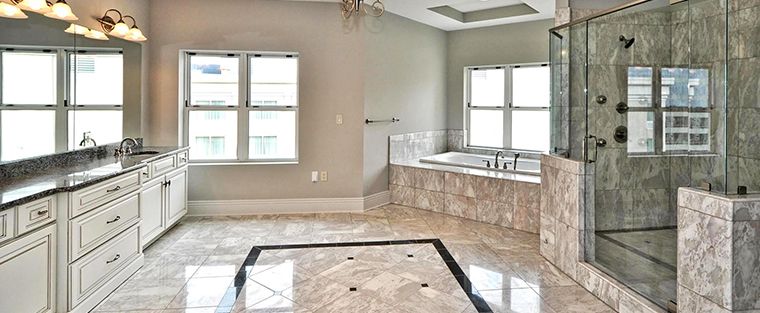
Marble is popular because it is a soft and can be machined, milled and tumbled, making it easy to work with. There are different types of marble, and it comes in different tile sizes. No two marble tiles tend to be the same, owing to different ‘veining’ patterns as well as color, although the same variety has a more or less uniform color or staining. However, this is also what makes it unique and preferred, as the plethora of different patterns all come together to give it that unique and special look, also lending a touch of elegance to your bathroom.
Marble flooring has drawbacks when used as bathroom flooring. Let’s take a closer look:

The problem with marble bathroom floor
The closer to Greece and Italy the marble has been sourced, the more likely it is to sustain its appearance in a damp and/or wet environment. More veining only points to an increased iron content percentage in the stone. This is not necessarily a good thing as we all know what happens to iron in such moist conditions as may be prevalent in a typical bathroom – iron oxide or rust tends to be form. The best way to check before installation is to soak a tile in a bucket of water for two days and observe for some days what happens to its color afterward.
Marble bathroom floor is also a highly absorbent material. Dropping your dye in a marble-tiled bathroom could result in the flooring getting stained. As such, it doesn’t make sense to use marble for children’s bathrooms. If you were thinking of getting marble for your bathroom, testing various lotions and acidic materials like lemon or floor cleaning liquids on the grade of marble you had in mind might help in making a more informed decision. Etching may also occur and maintenance might turn out to be harder than you think.
Why granite bathroom floor is better
Granite bathroom floor offer distinct advantages over marble flooring. Granite tile bathroom options provide a harder surface with consistent appearance and greater resistance to etching. While the initial cost of granite bathroom floor installation might be higher, the reduced maintenance requirements make the investment justifiable.
Individuals who have opted for marble bathroom flooring often note its slipperiness, necessitating the use of a bathmat to prevent accidents when stepping out of the tub or shower cubicle. In contrast, such concerns are significantly diminished with granite, rendering it a more pragmatic selection for the bathroom floor.
Additionally, concerns regarding tile discoloration are less likely to arise with granite, ensuring that your bathroom maintains its original appearance long after the flooring installation.
